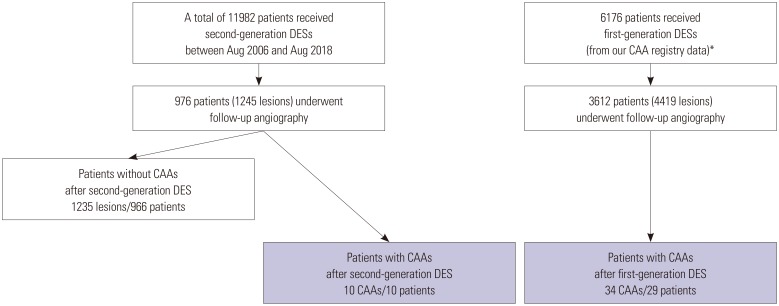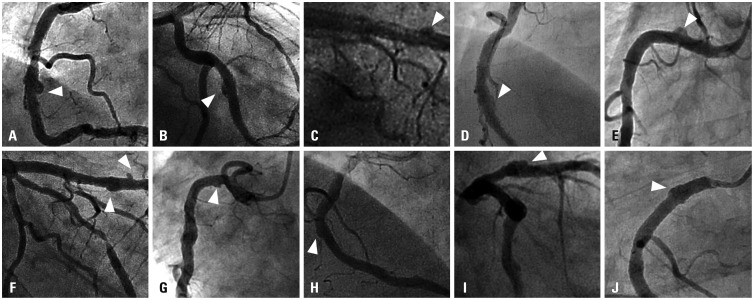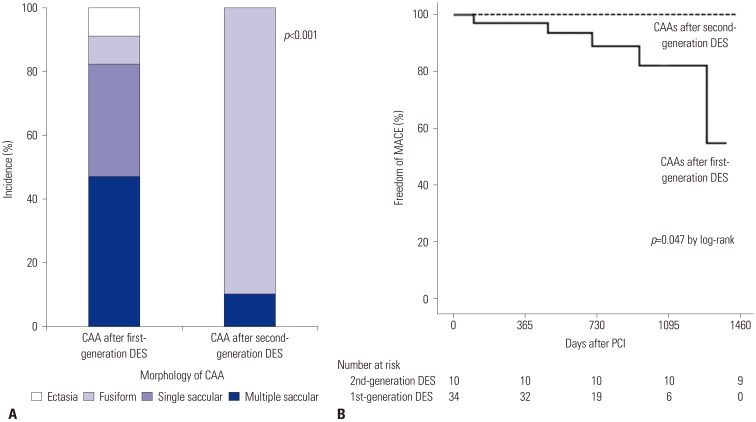Yonsei Med J.
2019 Sep;60(9):824-831. 10.3349/ymj.2019.60.9.824.
Coronary Artery Aneurysm after Second-Generation Drug-Eluting Stent Implantation
- Affiliations
-
- 1Division of Cardiology, Department of Internal Medicine, Severance Cardiovascular Hospital, Yonsei University Health System, Seoul, Korea. mkhong61@yuhs.ac
- 2Division of Cardiology, Department of Internal Medicine, Gangnam Severance Hospital, Seoul, Korea.
- 3Cardiovascular Research Institute, Yonsei University College of Medicine, Seoul, Korea.
- KMID: 2457478
- DOI: http://doi.org/10.3349/ymj.2019.60.9.824
Abstract
- PURPOSE
We evaluated the incidence, predictors, and prognosis of coronary artery aneurysm (CAA) after second-generation drug-eluting stent (DES) implantation.
MATERIALS AND METHODS
A total of 976 consecutive patients (1245 lesions) who underwent follow-up angiography after second-generation DES implantation were analyzed. Incidence and predictors of CAA were assessed, and clinical prognosis was compared with 34 cases of CAA after first-generation DES implantation using previous CAA registry data.
RESULTS
All 10 cases of CAA (0.80% per lesion) in 10 patients (1.02% per patient) were detected at follow up. Compared to lesions without CAA, those with CAA had greater involvement of the proximal segment (90% vs. 51%, p=0.014), a higher proportion of pre-intervention, a Thrombolysis in Myocardial Infarction score of 0 or 1 flow (80% vs. 16%, p<0.001), more chronic total occlusions (40% vs. 10%, p<0.001), and longer implanted stents (41.9±23.2 mm vs. 28.8±14.8 mm, p=0.006). As for CAA morphology, instances of CAA after second-generation DES were predominantly the single fusiform type (90%), whereas instances of CAA after first-generation DES were multiple saccular (47%) and single saccular (35%) types (p<0.001). Myocardial infarction with stent thrombosis occurred in 5 patients with CAA after first-generation DES (15%), and no adverse events were observed in patients with CAA after second-generation DES over a median follow-up duration of 4.3 years (p=0.047, log-rank).
CONCLUSION
Although CAAs after second-generation DES implantation were detected at a similar incidence to that for CAAs after first-generation DES implantation, second-generation DES-related CAAs had different morphologies and more benign clinical outcomes versus first-generation DES-related CAAs.
MeSH Terms
Figure
Cited by 1 articles
-
Long-term Clinical Outcomes of Drug-Eluting Stent Malapposition
Seung-Yul Lee, Gary S. Mintz, Jung-Sun Kim, Byeong-Keuk Kim, Yangsoo Jang, Myeong-Ki Hong
Korean Circ J. 2020;50(10):880-889. doi: 10.4070/kcj.2020.0198.
Reference
-
1. Alfonso F, Pérez-Vizcayno MJ, Ruiz M, Suárez A, Cazares M, Hernández R, et al. Coronary aneurysms after drug-eluting stent implantation: clinical, angiographic, and intravascular ultrasound findings. J Am Coll Cardiol. 2009; 53:2053–2060. PMID: 19477355.2. Aoki J, Kirtane A, Leon MB, Dangas G. Coronary artery aneurysms after drug-eluting stent implantation. JACC Cardiovasc Interv. 2008; 1:14–21. PMID: 19393139.
Article3. Joo HJ, Yu CW, Choi R, Park J, Lee HJ, Kim JS, et al. Clinical outcomes of patients with coronary artery aneurysm after the first generation drug-eluting stent implantation. Catheter Cardiovasc Interv. 2018; 92:E235–E245. PMID: 29164770.
Article4. Ahn CM, Hong BK, Kim JY, Min PK, Yoon YW, Lee BK, et al. Incidence and natural history of coronary artery aneurysm developing after drug-eluting stent implantation. Am Heart J. 2010; 160:987–994. PMID: 21095290.
Article5. Zbinden R, Eshtehardi P, Cook S. Coronary aneurysm formation in a patient early after everolimus-eluting stent implantation. J Invasive Cardiol. 2008; 20:E174–E175. PMID: 18460723.6. Kadakia MB, Epps KC, Julien ME, Ogbara J, Giri J, Kolansky DM, et al. Early aneurysm formation after everolimus-eluting stent implantation. Circ Cardiovasc Interv. 2014; 7:266–267. PMID: 24737336.
Article7. Goldberg A, Zdorovyak A, Rosenfeld I, Nordkin I. Early development of coronary artery aneurysms after implantation of biolimus-eluting stent with biodegradable polymer. Int J Cardiol. 2015; 184:487–488. PMID: 25756573.
Article8. Cutlip DE, Windecker S, Mehran R, Boam A, Cohen DJ, van Es GA, et al. Clinical end points in coronary stent trials: a case for standardized definitions. Circulation. 2007; 115:2344–2351. PMID: 17470709.9. Thygesen K, Alpert JS, Jaffe AS, Chaitman BR, Bax JJ, Morrow DA, et al. Fourth universal definition of myocardial infarction (2018). J Am Coll Cardiol. 2018; 72:2231–2264. PMID: 30153967.
Article10. Slota PA, Fischman DL, Savage MP, Rake R, Goldberg S. Frequency and outcome of development of coronary artery aneurysm after intracoronary stent placement and angioplasty. Am J Cardiol. 1997; 79:1104–1106. PMID: 9114773.
Article11. Bell MR, Garratt KN, Bresnahan JF, Edwards WD, Holmes DR Jr. Relation of deep arterial resection and coronary artery aneurysms after directional coronary atherectomy. J Am Coll Cardiol. 1992; 20:1474–1481. PMID: 1452919.
Article12. Rab ST, King SB 3rd, Roubin GS, Carlin S, Hearn JA, Douglas JS Jr. Coronary aneurysms after stent placement: a suggestion of altered vessel wall healing in the presence of anti-inflammatory agents. J Am Coll Cardiol. 1991; 18:1524–1528. PMID: 1939956.
Article13. Finn AV, Nakazawa G, Joner M, Kolodgie FD, Mont EK, Gold HK, et al. Vascular responses to drug eluting stents: importance of delayed healing. Arterioscler Thromb Vasc Biol. 2007; 27:1500–1510. PMID: 17510464.14. Stähli BE, Camici GG, Steffel J, Akhmedov A, Shojaati K, Graber M, et al. Paclitaxel enhances thrombin-induced endothelial tissue factor expression via c-Jun terminal NH2 kinase activation. Circ Res. 2006; 99:149–155. PMID: 16794185.
- Full Text Links
- Actions
-
Cited
- CITED
-
- Close
- Share
- Similar articles
-
- Successful Treatment of a Coronary Artery Aneurysm that Developed with In-Stent Restenosis after Drug-Eluting Stent Implantation
- A Case of Coronary Artery Aneurysm after Sirolimus-Eluting Stent Implantation
- Angiographic spontaneous pseudo-resolution of a coronary artery aneurysm after implantation of a sirolimus-eluting stent
- Risk of Stent Stenosis after Implanting a First-Generation Drug-Eluting Stent and Drug Balloon Angioplasty
- Rupture and Spontaneous Sealing of a Coronary Aneurysm After Deployment of Drug-Eluting Stent




